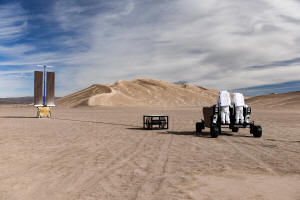California startup Astrolab unveils space rover, more than a mere 'moon
buggy'
 Send a link to a friend
Send a link to a friend
 [March 11, 2022]
By Steve Gorman [March 11, 2022]
By Steve Gorman
LOS ANGELES (Reuters) - A Los Angeles-area
startup founded by a veteran spaceflight robotics engineer unveiled on
Thursday its full-scale, working prototype for a next-generation lunar
rover that is just as fast as NASA's old "moon buggy" but is designed to
do much more.
The company, Venturi Astrolab Inc, released photos and video showing its
Flexible Logistics and Exploration (FLEX) vehicle riding over the rugged
California desert near Death Valley National Park during a five-day
field test in December.
Astrolab executives say the four-wheeled, car-sized FLEX rover is
designed for use in NASA's Artemis program, aimed at returning humans to
the moon as early as 2025 and establishing a long-term lunar colony as a
precursor to sending astronauts to Mars.
Unlike the Apollo-era moon buggies of the 1970s or the current
generation of robotic Mars rovers tailored for specialized tasks and
experiments, FLEX is designed as an all-purpose vehicle that can be
driven by astronauts or operated by remote control.

Built around a modular payload system inspired by conventional
containerized shipping, FLEX is versatile enough to be used for
exploration, cargo delivery, site construction and other logistical work
on the moon, the company says.
"For humanity to truly live and operate in a sustained way off Earth,
there needs to exist an efficient and economical network all the way
from the launch pad to the ultimate outpost," Astrolab founder and CEO
Jaret Matthews said in a statement announcing the rover's development.
If NASA adopts FLEX and its modular payload platform for Artemis, it
would become the first passenger-capable rover to ply the lunar surface
since Apollo 17, the last of six original U.S. manned missions to the
moon, in December 1972.
Apollo 17's lunar roving vehicle set a moon speed record of 11 miles per
hour (17.7 km/h). FLEX can move just as swiftly.
[to top of second column]
|

A handout image shows a prototype of California startup Astrolab 's
Flex lunar rover, that will be able to be operated directly by
astronauts on the Moon or remotely by NASA's engineers on Earth,
being tested in Death Valley National Park at the Dumont Dunes in
December, 2021 and obtained by Reuters on March 10, 2022.
 Apollo's astronauts found "they
spent just as much time off the ground as on it at that speed, so
it's kind of a practical limit for the moon," where gravity is
one-sixth that of Earth, Matthews, a former rover engineer for
NASA's Jet Propulsion Laboratory, told Reuters in an interview on
Wednesday.
While Apollo LRVs carried up to two astronauts seated at its
controls like a car, FLEX passengers - as many as two at a time -
ride standing in the back, driving the vehicle with a joystick
either astronaut can maneuver.
The rover itself, with the approximate wheelbase of a Jeep, weighs
just over 1,100 pounds (500 kilograms) but has a cargo capacity of
3,300 pounds, about the same as a light-duty pickup truck.
With its solar-powered battery fully charged, the vehicle can run
for eight hours with astronauts aboard and has sufficient energy
capacity to survive the extreme cold of a lunar night, up to 300
hours in total darkness, at the moon's south pole, Matthews said.
During the FLEX field test at the Dumont Dunes Off-Highway
Recreation Area north of Baker, California, adjacent to Death
Valley, the rover was piloted by retired Canadian astronaut Chris
Hadfield, who is an Astrolab advisory board member, and MIT
aerospace graduate student Michelle Lin.
Video showed the pair dressed in mock spacesuits riding on the
vehicle over a sand dune and using it to transport and set up a
large, vertical solar array.
"It was huge fun to drive the FLEX," Hadfield said in the video.
(Reporting by Steve Gorman in Los Angeles)
[© 2022 Thomson Reuters. All rights
reserved.] This material may not be published,
broadcast, rewritten or redistributed.
Thompson Reuters is solely responsible for this content.
 |